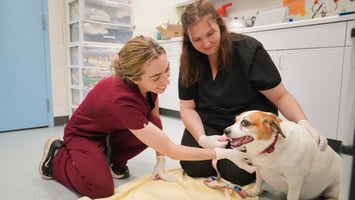Friends of the Riney Canine Health Center, Thank you for joining our pack! I’m Aly Cohen, an...
Dog Bite Prevention - April 2025
.png?width=958&height=958&name=Dog%20Behavior.shutterstock_1433761928%20(2).png) Friends of the Cornell Riney Canine Health Center,
Friends of the Cornell Riney Canine Health Center,
Growing up, our family always had a dog in the house, and to this day, I can’t imagine my life without one. Every dog I have had throughout my life has had a significant impact on me personally and as a veterinarian. I feel incredibly fortunate to have spent my childhood with my dogs as my best friends.
Bringing a dog and child together can be a beautiful experience, fostering lifelong friendships while teaching responsibility, empathy, and companionship. However, it’s essential to ensure their relationship is safe and positive through guidance, training, and supervision. This month, in recognition of Bite Prevention Week, I want to discuss how to teach children—and even our adult friends and family—safe ways to interact with dogs and understand canine body language.
Approximately 4.5 million people are bitten by dogs each year, with children being the most commonly injured. Bites can happen for many reasons, including lack of early and proper socialization, punishment-based training, medical issues, or past traumatic experiences. Often, dogs display many warning signs through their body language before resorting to biting. However, without knowing what to look for, it may seem like a bite happened "out of nowhere."
While it’s important to acknowledge these risks, I also want to highlight the immense benefits of the human-animal bond, particularly for children. Research from the Human Animal Bond Research Institute shows that pets can enhance a child’s cognitive, social, and emotional growth. The presence of a family pet can boost emotional expression and control, while even brief interactions with dogs have been shown to lower stress levels. Pets also serve as nonjudgmental companions, helping children learn to express and interpret non-verbal communication. Additionally, caring for a pet fosters a sense of purpose and responsibility, fulfilling a child's need to feel important and needed.
Knowing all the benefits of the human-animal bond, how can we ensure safe interactions between children and dogs? Supervision of all interactions is crucial. Children should also be taught how and when to pet a dog, ensuring that they avoid reaching for the dog’s head, paws, or other sensitive areas. Instead, they should pet on the side, back, or chest. Children also need to understand clear boundaries, such as not interacting with a dog while they are sleeping, eating, or have a treat or toy. Running, screaming, or chasing should also be avoided, as these actions can startle some dogs or trigger a chase response, potentially leading to an accident. Instead of high-arousal activities such as tug-of-war or running around with a dog, low-arousal activities like taking walks or engaging in basic training exercises (if the child is old enough) help foster a strong bond between a dog and a child. Since not every dog behaves like a family pet, children should always ask for permission before approaching or petting a dog they don’t know.
While children can be taught to respect a dog's space, pet gently, and avoid rough play, they may not always recognize subtle stress signals depending on their age. Adults must closely monitor interactions and intervene when necessary.
A useful tool in understanding dog body language is referred to as “the ladder of aggression.” This concept helps visualize how a dog’s fear, anxiety, or stress can escalate into a bite. Each "rung" on the ladder, denoted as a bullet point below, represents a progression in discomfort. Recognizing these early warning signs allows us to step in before a situation escalates.
Early signs of fear, anxiety, and stress:
- Yawning, blinking, excessive nose licking
- Turning head away, avoiding eye contact
- Turning body away or walking away
Escalating signs:
- Creeping backward, ears pulled back
- Standing crouched with tail tucked
- Lying down with a leg up
Critical warning signs:
- Stiff body, hard stare
- Growling
- Snapping
- Biting
By the time a dog growls, they have already tried to communicate their discomfort in subtler ways. It’s important never to punish a dog for growling. If they learn that growling leads to punishment, they may skip this warning altogether and go straight to biting. Instead, growling should be recognized as a crucial communication signal that the dog needs space.
Key safety tips:
- Always supervise dog-child interactions.
- Teach children to respect a dog’s space, especially during meals or rest.
- Recognize stress signals like lip-licking, yawning, and stiffness.
- Provide a safe retreat space where the dog can go to relax.
- Redirect unwanted dog behaviors like jumping or mouthing using positive reinforcement.
- Consult a trainer or veterinary behaviorist early if fear or aggression arises.
By becoming familiar with dog body language and having clear boundaries, families can foster a safe, loving, and lasting bond between their dogs and children, ensuring happy and healthy interactions for years to come.
As always, thank you for being a Riney Canine Health Center member. We look forward to catching up with you next month!
Dr. Aly Cohen
Extension veterinarian
Cornell Richard P. Riney Canine Health Center
Other resources:
Anxious behavior: How to help your dog cope with unsettling situations
Rabies infections and prevention

-1.jpg?width=50&name=Aly%20in%20RCHC%20shirt%20(+%20Mishka)-1.jpg)


